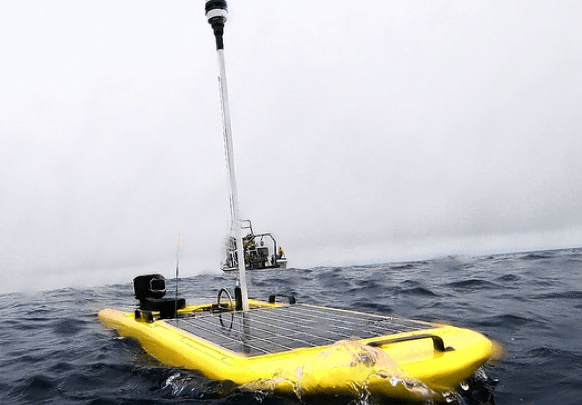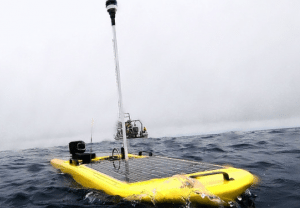Was The World’s ‘Northern-Most Island’ Erased From Charts?
by Kevin Hamilton (University of Hawaii) In 2021, an expedition off the icy northern Greenland coast spotted what appeared to be a previously uncharted island. It was small and gravelly,...




Departing from San Francisco on Thursday four robots began a voyage across the Pacific to ports in Japan and Australia. The purpose of the crossing is to foster new scientific discoveries by collecting vast amounts of ocean data. Liquid Robotics and Google Earth are powering the project with robotic hardware and software capable of transiting the ocean unassisted.
The four Wave Gliders are expected to collect approximately 2.25 million discrete data points during their more than 300 voyage. Along the way they will transmit valuable ocean data on salinity, water temperature, waves, weather, fluorescence, and dissolved particles. Further, the enormous data set will be provided free of charge – in real-time – to scientists, educators, students, and the general public.
During their 33,000 nautical mile journey, the Wave Gliders will travel across some of the world’s most challenging environments. The Wave Gliders will begin their journey together to Hawaii, and then split into pairs, one pair continuing to Japan (over the Marianas Trench, where Virgin Oceanic will complete the first of its Five Deep Dives) and the other pair to Australia.
When they reach their final destinations, the Wave Gliders will have earned a Guinness World Record for the longest voyage completed by an unmanned ocean vessel.
But it could be a perilous journey as the robots must navigate to avoid storms, floating debris and strong equatorial currents. At the launch, Bill Vass, Liquid Robotics’ chief executive, told reporters, “It’s a tough thing to do and we may not make it.”
In addition to natural hazards, the robot’s greatest challenge is avoiding ships. gCaptain met with Liquid Robotics at an exhibition in San Francisco last year who confirmed that the robots will be carrying AIS units to avoid approaching ships. “The robots will be alerted to oncoming vessels and have been programed with software that enables the units to maneuver and avoid a collision,” said one scientist.
Yet dangers remain.
The robots use wave energy to propel themselves and have a top speed of 2 knots. Further, the robots have a very low freeboard and antenna height which reduces the visibility of the unit and the distance at which it can locate nearby ships. Combined, these drawbacks limit the ability of the units to stay clear of ships.
Liquid Robotics is not looking to eliminate all risk, but according to Graham Hine, Liquid Robotics’ Senior Vice President for operations, “The mission is to push the boundaries of understanding, to prove to the world that this sort of technology can expand our understanding of the oceans.”
“Liquid Robotics invites scientists to embark on a grand challenge journey with us as we cross the Paciï¬c on a voyage of scientiï¬c discovery,” said Ed Lu, chief of innovative applications at Liquid Robotics. “These Wave Gliders are much like small ‘spacecraft’ that open up new opportunities for robotic exploration. I challenge all scientists who are interested in advancing ocean exploration to take advantage of this unique opportunity. What scientiï¬c questions can we address with this new and unique data set?”
The PacX Challenge partners are equally optimistic of success. According to Jenifer Austin Foulkes, the head of Google Oceans, “Most of the ocean remains unexplored with less than 10 percent of it mapped out. This expedition creates an opportunity for students, marine researchers, and aspiring oceanographers to follow these brave Liquid Robotics ocean robots as they cross the Pacific virtually through the Ocean Showcase on the Google Earth website. They can also check back daily in Google Earth to see the latest posts from scientists communicating weather and climate data back from these ‘R2D2s’ of the sea.“
NOTE TO MARINERS:
The robots are currently enroute from San Francisco to Hawaii. If your vessel is traveling this route please keep a good lookout for the units, monitor and plot their location daily (position updates are available via google earth) and provide them with a large CPA.
Join the gCaptain Club for curated content, insider opinions, and vibrant community discussions.


Join the 105,982 members that receive our newsletter.
Have a news tip? Let us know.
Access exclusive insights, engage in vibrant discussions, and gain perspectives from our CEO.
Sign Up




Maritime and offshore news trusted by our 105,982 members delivered daily straight to your inbox.



Essential news coupled with the finest maritime content sourced from across the globe.
Sign Up